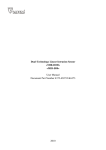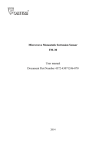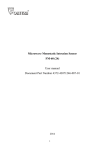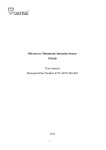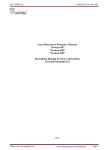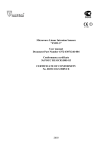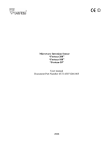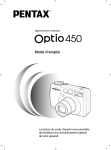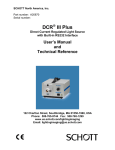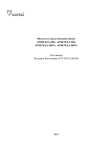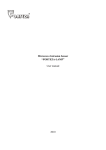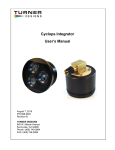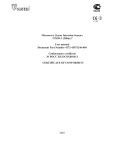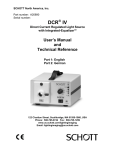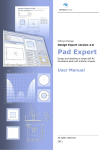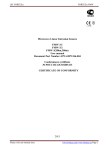Download Dual Technology Linear Intrusion Sensor MIR
Transcript
Dual Technology Linear Intrusion Sensor MIR-B50 User Manual Document Part Number 4372-43071246-073-01 2014 CONTENTS 1. 2. 3. 4. 5. 5.1. 5.2. 5.3. 6. 6.1. 6.2. 6.3. 7. 8. 8.1. 8.2. 8.3. 9. 9.1. 9.2. 9.3. 9.4. 9.5. 10. 10.1. 10.2. 11. 12. 13. Introduction ................................................................................................... Purpose .......................................................................................................... Specifications ................................................................................................ Sensor components........................................................................................ Sensor structure & operation ......................................................................... Operation principle ........................................................................................ Adjustment, control and indication parts ...................................................... Sensor operation ............................................................................................ Sensor construction ....................................................................................... Rx construction ............................................................................................. Tx construction .............................................................................................. Mounting kit .................................................................................................. Safety measures ............................................................................................. Mounting procedure ...................................................................................... Requirements for the protected sector and Rx and Tx arrangement ............. Sensor mounting ............................................................................................ Sensor connection ......................................................................................... Preparation of the sensor for the operation & adjustment ............................ Sensor preparation for its operation .............................................................. Tx and Rx adjustment ................................................................................... Possibility of sensor installation on sites, which don’t meet the requirements of the items 3.5, 8.1.1 .................................................................................... Thresholds alignment of the Rx microwave detection channel .................... Check of dual technology sensor operation .................................................. Maintenance check ........................................................................................ Performance check ........................................................................................ Maintenance .................................................................................................. Troubleshooting Guide.................................................................................. Storage ........................................................................................................... Transportation ............................................................................................... Certificate ...................................................................................................... 2 3 3 3 6 7 7 7 8 9 9 9 10 13 13 13 14 15 19 19 19 20 20 21 21 21 21 22 23 23 24 1. INTRODUCTION 1.1. The user manual contains information about the operation of the dual technology intrusion sensor MIR-B50 (below the sensor). There is the information required for the correct operation (use, transportation, storage and maintenance) of the sensor. The following abbreviations are used in this document: Tx - transmitter Rx - receiver MK - mounting kit MW – microwave detection channel IR – active infrared detection channel 2. PURPOSE 2.1. 2.2. 2.3. The sensor is intended to protect fences, perimeter sites, windows and inner facilities. The sensor combines two physical detection principles (IR and MW). It increases the sensor interference immunity and allows using the sensor in difficult interference conditions. The sensor is intended for continuous round-the-clock outdoor operation at an ambient temperature from -40˚up to +65˚C and relative humidity up to 98% at the temperature +35С. 3. SPECIFICATIONS 3.1. 3.2. 3.3. The recommended length of a protected sector: – 5…50 m Microwave and infrared detection channels have different configurations of the detection zone. The alarm is generated when both detection channels (microwave and infrared) are activated. As a result the final configuration of the detection zone coincides with the configuration of the infrared channel detection zone. That’s why the total detection zone coincides with the detection zone configuration of IR channel. The detection zone configurations (microwave and infrared) and their dimensions are given in fig.3.1 and table 3.1. Note. The detection zone is a volumetric part of the protected sector, any intruder movement in which disturbs the field and generates an alarm. 3 Fig. 3.1 L – length of a sector B – diameter of the MW detection zone D – diameter of the IR detection zone In fig.3.1 and table 3.1 the diameter (B) of the microwave detection zone and the diameter (D) of the infrared detection zone are given for the middle of the protected sector. Moving towards the receiver or transmitter these dimensions decrease gradually up to the geometry of the receiver and transmitter. Table 3.1 Dimension, maximum, m 3.4. 3.4.1. 3.4.2. 3.4.3. Length of a sector L, m 5 25 50 B 0,5 1,0 1,5 D 0,03 0,05 0,1 Main features of the infrared detection channel. Number of IR-rays - 1; Angle of the IR-ray divergence - 20; Light immunity to: - daylight and dc light sources – up to 20 000 lx; - ac light sources – up to 1000 lx; 3.4.4. Sensitivity (IR-ray overlap time) - 45 ms; 3.4.5. IR-ray interference immunity – up to 35 ms 3.5. The recommended distance from the axis of the detection zone up to fences, building walls and other motionless objects at the sector length: 25…50 m 1,0 m minimum; 4 3.6. 3.7. 3.8. 3.9. 3.10. 3.11. 3.12. 10…25 m 0,5 m minimum. The recommended distance from the axis of the detection zone can be less if the requirements of the item 9.3 are fulfilled. The sensor generates an alarm when: an intruder crosses the detection zone at a speed from 0,1 up to 6 m/sec (the minimum detection probability is 98 %); remote control signal is transmitted to Tx; An alarm is generated by breaking actuating relay contacts. The indicator ALARM MW+IR goes on for 3 sec minimum. This signal is sent from Rx by the yellow and pink cables marked NC (normally closed). The sensor generates the fault signal at: the absence of the Tx signal: at the infrared detection channel – the indicator ALARM IR on the Rx backboard goes on till the failure is eliminated; at the microwave detection channel – the indicator ALARM MW on the Rx backboard goes on till the failure is eliminated; at the infrared and microwave detection channels – all Rx indicators go on and actuating optoelectronic relay contacts are broken (the yellow and pink cables marked NC, NC) till the failure is eliminated; the absence of supply voltage or at its reduction lower than 15 V; failure of Rx or Tx. The actuating relay characteristics are: maximum switching current is up to 0,1 A; maximum voltage is up to 50 V; maximum resistance is up to 110 Ohm in the closed condition (together with lightning guard elements). The sensor generates an alarm at the opening of the Rx cover, under which there are adjusters. The contacts of the tamper button are open at the cover opening. This alarm is transmitted to Rx by the green and grey cables marked TAMPER, TAMPER. Operating characteristics of the tamper: current is up to 0,2 A; voltage is up to 80 V. The sensor power supply: from 15 up to 30 VDC with the maximum pulsation of 0,2 V. The maximum current consumption is 50 mA at 24 VDC. The sensor operation can be controlled remotely by biasing the dc voltage of 5…30 V at the cable marked RC on the Tx unit. The duration of this test is 2…4 sec. The sensor doesn’t generate the false alarm at: rain, snow, thick fog; solar radiation; wind speed up to 30 m/sec; moving of objects with the linear dimensions up to 0,2 m (birds or small animals) not closer than 5 m from Rx or Tx; 5 3.13. 3.14. 3.15. 3.15. 3.16. the influence of ultra short waves emissions of the range 150-175 MHz and the power up to 40 W at a distance of 6 m minimum. The sensor is immune to some electromagnetic interference (voltage impulses in feed circuits, mains supply interruption, electrostatic discharge, electromagnetic field). Input circuits of Rx and Tx have the protection from electric pickups (including thunderstorms) with the amplitude up to 900 V. If there is the possibility of electric pickups with the amplitude more than 900 V, it is recommended to use the lightning guard unit LGU-4. The sensor mean lifetime is 8 years. Maximum dimensions of the units without a mounting kit, mm: Tx - 211x138x105; Rx - 211x138x105. Maximum weight of the units with a mounting kit, kg: Tx - 1,5; Rx - 1,5. 4. SENSOR COMPONENTS The sensor delivery kit is: 1. Receiver – 1 pc 2. Transmitter - 1 pc 3. Mounting kit including: - bracket – 2 pcs - buckle – 4 pcs - flexible corrugated pipe– 2 pcs - nonhermetic connector of corrugated pipe with junction box – 2 pcs. 4. Kit of tools and accessories including: - alarm cable - spanner S8x10 5. User manual 6. Package 7. Power supply unit PSU-U-24-0,5, junction box JB-15 (JB-30, JB-84), lightning guard unit LGU-4, brackets for wall mounting BRACKET-500, BRACKET300, BRACKET-120 are supplied at the customer’s order. 6 5. SENSOR STRUCTURE & OPERATION 5.1. Operation principle 5.1.1. The sensor is a bistatic dual technology device. Transmitter and receiver have microwave and infrared detection channels. The sensor principle of operation is based on generation of an electromagnetic field between Tx and Rx. This field forms a volumetric detection zone in the form of a long ellipsoid of rotation. The sensor also generates an infrared ray (fig. 3.1). The sensor registers changes of the field and overlapping of the infrared ray when an intruder crosses the protected zone. 5.1.2. When an intruder crosses the detection zone, it causes changes of the signal amplitude in Rx (microwave detection channel) and overlapping of the infrared ray. The signal passes through the amplifier and is compared with the thresholds value according to the algorithm. The signal from the infrared Rx module is analysed (time of overlapping and modulation depth). If the signal change on the Rx input is provoked by a person passage and the infrared beam is overlapped for the required time, then Rx generates an alarm breaking actuating relay contacts. 5.1.3. Interference factors for the microwave detection channel are the following: small animals, electromagnetic interference, swinging of tree branches or gates, transport movement near the detection zone, motionless objects (e.g. snow cover). Interference factors for the infrared detection channel are the following: thick fog, heavy snow or leaf fall, powerful natural or artificial light sources. Multi-thresholds operation algorithm, combining different detection principles, permits to reduce the number of false alarms. 5.2. Adjustment, control and indication parts 5.2.1. Adjustment, control and indication parts of the microwave detection channel Values of the Rx thresholds of the microwave detection channel are set by a user during the sensor operation and with the help of the threshold controller MINMAX. The thresholding is performed by slow rotation of the resistor axis with a screwdriver. In this case the threshold value changes from minimum (MIN) to maximum (MAX). The minimal thresholds value corresponds to the maximal sensitivity of the microwave detection channel. The Rx input signal of the microwave detection channel is controlled with the tester on the jack marked TEST MW (test jack).The more the TEST MW voltage is, the more the Rx input signal is and vice versa. The sensor is operable at the TEST MW voltage from 0,1 up to 4,8 V. Connect a voltmeter to the TEST MW jack, press the AGC MW button and compare the TEST MW voltage with the permissible voltage values. The light indicator ALARM MW informs about the following operation modes: 7 - no light signal of the ALARM MW indicator – the standby mode of the microwave detection channel; interrupted light signal of the ALARM MW indicator – fast adjustment of the microwave detection channel amplifier; light indicator goes on for 3 sec. minimum – generation of the alarm signal of the microwave detection channel. 5.2.2. Adjustment, control and indication parts of the infrared detection channel. The Rx input signal of the infrared detection channel is controlled with the tester on the jack marked TEST IR (test jack).The more the TEST IR voltage is, the more the Rx input signal is and vice versa. The sensor is operable at the TEST IR voltage from 1,0 up to 3,5 V. The light indicator ALARM IR informs about the following operation modes: - no light signal of the ALARM IR indicator – the standby mode of the infrared detection channel; - light indicator goes on – generation of the alarm signal of the infrared detection channel. 5.2.3. Sensors indication parts The light indicator ALARM MW+IR informs about the following operation modes: - no light signal – the standby mode of the sensor; light indicator goes on for 3 sec. minimum – generation of alarm signal of the infrared detection channel. 5.2.4. On the Rx unit the tamper button is placed in order to prevent unauthorized openings of the Rx cover. In the operating condition the tamper contacts are closed, when the sensor cover is opened, the contacts are broken. The alarm circuits marked TAMPER (green and grey cables) are broken too. - 5.3. Sensor operation 5.3.1. The preparation to the sensor operation is the following: - preparation of the sector; - signal cables and power supply laying; - Tx and Rx installation; - sensor connection (connection of power supply and intruder alarm loops); - alignment of Tx and Rx antennas; - alignment of Rx thresholds of the microwave detection channel. The principles and methods of these steps are given in the items 8-9. 8 5.3.2. The sensor has the following operation modes: - standby mode – actuating relay contacts are closed, indicator ALARM MW+IR is OFF; - alarm mode – actuating relay contacts are open, indicator ALARM MW+IR is ON for 3 sec. minimum; - tamper mode of Rx – TAMPER contacts are open. 5.3.3. The receiving and control device perform the receipt and indication of alarms. The sensor operates with the receiving-control devices, which control relay contacts. 5.3.4. Periodically the remote control of the sensor should take place. The constant voltage from 5 up to 30 V is biased for 2…4 sec on the Tx cable marked RC (green cable). The beaming of Tx is interrupted for the time and then the Rx unit generates an alarm. The alarm generation confirms the sensor and alarm loop operability. The control frequency is assigned by the user. 5.3.5. Besides it is necessary to check periodically the technical state of the sensor and its servicing. The recommended frequency of the checks is given in the item 10. 6. SENSOR CONSTRUCTION 6.1. Rx construction 6.1.1. Rx and Tx units are placed in the dust- and splash-proof enclosures. 6.1.2. Rx construction and its fastening elements to the support are shown in fig. 6.1. The bearing structure of Rx is the base 4. The infrared and radio transparent enclosure 5 is fastened to the base. In the lower part of the enclosure there are three holes preventing condensed fluid accumulation in Rx. The sight leaves 15 for easier sensor alignment are on the side faces of the base 4. It is necessary to take off the cover 6 to get the access to the adjustment and indication elements. Rx is connected to the receiving-control device with the six-wire cable 8. Rx is mounted on the support 1 with the bracket 2 and two buckles 13. It provides the rotation of the unit horizontally at an angle 360; vertically: upwards - at an angle 45, downwards – at an angle 15. Arrangement and markings of components, controllers, adjustment and indication elements, located under the cover 6, are shown in fig. 6.2. Note. To increase the unit rotation angle in vertical plane, it is recommended to install the bracket 2 of the turn 180. 6.2. Tx Construction 6.2.1. Tx construction and its bracket are the same as the Rx construction (see fig.6.1). The difference is in the following: there are no cover 6, controllers, adjustment and indication elements; the three-wire cable is used instead of the six-wire cable 8. 9 6.3. Mounting kit 6.3.1. Mounting kit of the dual technology sensor (MW+IR) includes two brackets and four buckles for Rx and Tx mounting on the support of the diameter 70…90 mm. 6.3.2. The mounting kit for Tx, Rx for wall or fence mounting can be delivered by order (fig. 6.3, 6.4). The example of the sensor mounting on a wall with the brackets of 120 mm (e.g. on a wall adjoining to a fence) is shown in fig. 6.3. The sensor mounting with the brackets of 350 or 500 mm for fence, windows and doors protection is shown in fig. 6.4. The rotation angles of Tx (Rx) units on the bracket in horizontal plane - 180˚, in vertical plane: upwards - 17˚, downwards – 45о. Fig. 6.1 1-support 2-bracket - 1 pc - 1 pc 9-bolt M6x35 10-nut M6 10 - 1 pc - 1 pc 3-bushing 4-base 5-enclosure 6-cover 7-corrugated tube 8-cable - 1 pc - 1 pc - 1 pc - 1 pc - 1 pc - 1 pc 11-washer 6 12-bolt M6x35 13-buckle 14-bushing 15-sight leaf - 2 pcs - 1 pc - 2 pcs - 2 pcs - 2 pcs Note: 1. The support mounting on the ground is given in fig.8.3 (item 8.2). 2. The dimensions are given into mm. Fig.6.2 1 – indicator ALARM MW+IR 2 – indicator ALARM IR 3 – indicator ALARM MW 4 – thresholds MIN– MAX 5 – test jack TEST MW 6 - AGC MW button 7 –tamper button TAMPER 8 – test jack TEST IR 11 1- bracket 2-metal ring 3- figured washer 1- fence 2- bracket 3- figured washer 4- metal bracket 5- Rx unit 6- screw М6х50 -1pc -1pc -1pc Fig. 6.3 4- washer 6 5- nut М6 Fig. 6.4 – 1pc – 1pc – 2pcs – 1pc – 1pc – 4pcs 7- bolt М6х35 8- metal ring 9- nut М6 10- washer 6 11- bolt М6х14 -1pc -1pc – 1pc – 1pc – 2pcs – 4pcs – 1pc Note. Dear user! The manufacturer of the sensor constantly upgrades its quality and reliability. That’s why there can be design modifications unspecified in the documents delivered with the sensors. Nevertheless, the main specifications are valid. 12 7. SAFETY MEASURES 7.1. 7.2. 7.3. 7.4. The current safety standards for the operation with electrical facilities with the voltage up to1000 V should be observed during mounting, preventive maintenance and repair of the sensor. Cables should be laid, terminated and connected to the sockets only when the supply voltage is OFF. It is prohibited to mount and maintain the sensor at thunderstorms. Installation and maintenance of the sensor should be performed only by people, who underwent special safety trainings and became acquainted with safety measures. 8. MOUNTING PROCEDURE 8.1. Requirements for the protected sector and Rx and Tx arrangement 8.1.1. The protected sector should meet the following requirements to ensure the microwave detection channel operability: a) line of sight between Tx and Rx; b) moving or motionless objects should not be situated in the detection zone of the microwave detection channel (see fig. 3.1); Note. The presence of motionless objects is permissible if the requirements of the item 9.3 are fulfilled. 8.1.2. The protected sector should meet the following requirements to ensure the infrared detection channel operability: a) line of sight between Tx and Rx; b) moving or motionless objects should not be situated in the detection zone of the infrared detection channel (see fig. 3.1); c) sensor units should not slant under the influence of wind, temperature oscillations, vibrations and etc. 8.1.3. Advice how to reduce influence of interferences (false alarms possibility) on the microwave detection channel: a) do not allow the presence of moving objects closer than 1,5 m from the microwave channel detection zone (people and animals, tree branches, high grass, wings of gates); b) do not allow transport movement closer than 2,5 m from the microwave channel detection zone. 8.1.4. Advice how to reduce influence of interferences (false alarms possibility) on the infrared detection channel: 13 a) b) 8.2. remove snow and dust from sensor units; exclude the influence of direct sunlight or powerful infrared lighting units on Rx in the receiving direction ±20 (see fig. 6.1). Sensor mounting 8.2.1. Only Tx units or only Rx units should be installed at the joint of two adjoining sectors. Tx and Rx units should not be installed next to each other on adjoining sectors. 8.2.2. Ground installation type with supports is shown in fig. 8.3. 8.2.3. Wall mounting (along the top of fence) of 350 mm bracket is shown in fig. 6.4. Level difference of the fence edge relative to the microwave detection channel axis must not exceed 0,35 m Attention! The right orientation of Tx and Rx on the bracket: drain ports should be downwards! It is obligatory to install the corrugated pipe! 8.2.4. Use of junction boxes JB-30 and power supply units PSU-U-24-0,5 To connect the cable 8, protected with the corrugated pipe 7, with the JB (or PSU), one should remove one of the threaded cable connections PG9 and place the bushing 14 with the corrugated pipe 7 into the hole. It is recommended to use one PSU-U-24-0,5 for power supply of two contiguous sensors. It should be remembered that there are five free terminal blocks in PSU-U-24-0,5 (“1” – “5”). ATTENTION! To reduce the level of electromagnetic interferences, it is recommended to mount the power supply unit at a distance up to 300 m from the place where the sensors are installed. 1 – metal support 2 - plastic plug 3 - hole for the cable input inside the support 4 - hole for the main cable and sensor cable input 5 - hole for the main cable input 6 - concrete (gravel) 7 - dowels for prevention the unauthorized dismounting of the support 8- ground Note. 1. For A size the ground should be laid after installation works. 2. Dimensions are given in millimeters. Fig. 8.3 14 8.3. Sensor connection 8.3.1. Connect the necessary power, signal and remote control circuits. Rx and Tx units are connected with its own cables. The color or marking of the cable conductors indicate their purpose. The information about cable conductors marking, color and purpose is given in Table 8.1. ATTENTION! It is categorically forbidden to “earth” the sensor circuits directly. It is necessary to use the lightning guard unit LGU-4 Table 8.1 Marking “+” Rx Color white “-“ brown “NC” yellow “NC” pink “TAMPER” green “TAMPER” grey Purpose Supply voltage Actuating relay contacts Marking “+” Tx Color white “-“ brown “RC” green Purpose Supply voltage Remote control + 5…30 V Tamper button 8.3.2. The type and rating of the terminal resistor of the security system loop (resistor, condenser and diode) are determined by the type of the receiving-control device, with which the sensor is connected. Usually it is a resistor. The rated resistance of this resistor should take into account the resistance of the lightning guard circuit (this resistor - 100 Ohm) and the resistance of the security system loop (depends on the chosen cable type and its length). 8.3.3. The contacts of the Rx tamper button (“TAMPER”) can be connected to the receiving-control device with a separate loop. In this case the separate signal indicates the opening of the Rx cover. The second variant is to connect the tamper contacts in series with the actuating relay contacts. In this case an alarm will be registered by one channel of the receiving-control device at the relay actuation or at the opening of the Rx cover. 8.3.4. The approximate diagram of the sensor connection using the junction box JB-15 is shown in fig. 8.4. The contacts of the tamper button are connected in series with the actuating relay contacts. The sensor receives a signal from the remote control (RC) when an additional button is installed in the control room. It is possible to install one button for several sensors. In this case the button pressing checks the operation of all sensors. 15 The approximate diagram of the sensor connection using the lightning guard unit LGU-4 is shown in fig. 8.5. The approximate diagram of the sensor connection to the supply unit PSU-U-240,5 is shown in fig. 8.6. 8.3.5. On the lengthy perimeters it is recommended to use junction boxes JB-30 (with 30 circuits), JB-84 (with 84 circuits) for cables switching. TR – terminal resistor of the control-receiving device Fig. 8.4 16 TR – terminal resistor of the control-receiving device Fig. 8.5 17 18 TR – terminal resistor of the control-receiving device Fig. 8.6 9. PREPARATION OF THE SENSOR FOR THE OPERATION AND ADJUSTMENT 9.1. Sensor preparation for its operation 9.1.1. Check the connection of supply circuits and output circuits of the sensor. Switch ON the sensor power supply. 9.2. Tx and Rx adjustment 9.2.1. Tx and Rx are adjusted according to the angle of elevation and the azimuth with the aim to achieve the max TEST IR voltage. 9.2.2. Two persons should adjust the sensor. One of them is near Rx, the other – next to Tx. 9.2.3. The alignment includes the following procedures: connect the tester to the socket TEST IR using the alarm cable from the kit in the mode of constant voltage measuring; loosen the bolts12 and 9 (see fig.6.1) of Tx and Rx; turn Tx and Rx in vertical and horizontal planes. Adjust them using the sight leaves on the sidewalls of the antennas (preliminary adjustment); turn Tx and Rx in vertical and horizontal planes. Achieve the maximum value of voltmeter (not less than 3,0 V) on the socket TEST IR (exact adjustment); tighten the bolts 12 and 9; check the TEST IR voltage value after the alignment. It should be equal 3,03,5 V; check the TEST MW voltage value after the alignment. It should be equal 1,0-4,5 V. If the TEST IR and TEST MW voltages are beyond the limits, it is necessary to repeat the alignment vertically and horizontally for more accurate alignment. Note: The sensor is operable at the TEST IR voltage from 1,0 up to 3,5 V, at the TEST MW voltage from 0,1 up to 4,8 V. Margin limits during alignment are recommended with the aim to provide the capacity of signal level. It provides longterm and stable operability of the sensor. - disconnect the tester. 19 9.3. Possibility of sensor installation on sites, which don’t meet the requirements of the items 3.5, 8.1.1. 9.3.1. The influence of different objects (especially lengthy ones) situated in the detection zone is in the following: – decrease of microwave input signal; – unequal sensitivity along the protected site of both microwave and infrared detection channels; – detection zone deformation of the microwave channel. 9.3.2. Minimum input signal of the microwave detection channel If after alignment according to the item 9.2 the TEST MW voltage is less than 1,0 V, it is necessary to do the following: – reduce the sector length; – change the location of Tx and Rx units relative to the wall or fence by 30 50 mm and repeat the alignment. If it is impossible to get 1,0 V on the TEST MW socket, as an exception it is admissible to use the sensor at the signal level not less than 0,7 V. 9.3.3. The alignment of the microwave detection channel thresholds and the check of the infrared channel detection ability should be carried out very carefully doing at least 10 check passes along the whole sector length. 9.3.4. If the detection zone configuration is deformed, one should check if movements outside the detection zones mentioned in the item 3.3. 9.3.5. It is necessary to carry out sensor operation testing and to decide about the possibility of sensor application according to its results. 9.4. Thresholds alignment of the Rx microwave detection channel 9.4.1. Set the controller MIN-MAX in the position MAX. Regulate the thresholds, crossing the protected sector along its whole length (beginning with the middle of the sector). It is necessary to go out of the detection zone at a distance of 1-2 m to change Rx unit to the standby mode (otherwise the results of the previous passage will influence on the following one). When the sensor generates alarms, ALARM MW indicator goes on for 3 sec. minimum. The following passage can be done after the indicator ALARM MW switching off. If the signal is not generated during the passage, the controller MIN-MAX is turned a little counterclockwise and the alignment is continued. 20 Do some check passes in “problem” places of the detection zone: hollows, hills, near tree trunks. Regulate the thresholds of the microwave detection channel if necessary. Note. If check passages are done at a medium speed, the threshold values allow to detect an intruder moving at a speed from 0,3 up to 6 m/sec. To expand the speed range up to 0,1…6 m/sec you should conduct additional alignment crossing the sector at a speed of 0,1 m/sec. Align the thresholds very attentively as “underrating” of the thresholds might provoke a lot of false alarms; “overrating” of the thresholds might provoke failures in the sensor operation. 9.5. Check of dual technology sensor operation 9.5.1. Fulfilling the item 9.4.1 one should control that the indicators ALARM IR and ALARM MW+IR turn on when the sector is crossed. Close the Rx cover when the alignment is finished. It is recommended to test the sensor for 2-3 days after its alignment with the aim to detect possible errors in mounting and alignment. 10. MAINTENANCE CHECK 10.1. Performance check 10.1.1. During the exploitation it is recommended to test the sensor operability transmitting the remote control signal (RC). The customer sets the frequency of such testing. 10.2. Maintenance 10.2.1. The sensor maintenance should be conducted by people, who underwent special safety trainings. 10.2.2. During the sensor exploitation it is necessary to conduct check and preventive works. 10.2.3. Every month carry out visual examination of the sensor units and the protected sector. It is necessary to check: the absence of dust, dirt, snow and ice from the side of Tx signal transmission and Rx signal reception; the absence of foreign objects in the protected sector. 10.2.4. Every quarter: carry out all monthly works; 21 check the cables and cable connections. 10.2.5. During seasonal works one should control the grass height (in summer) and the snow cover height (in winter) in the detection zone. 11. TROUBLESHOOTING GUIDE List of possible troubles is given in Table 11.1. Table 11.1 Trouble Possible Cause 1. The receiving 1. Communication line control device is broken. constantly generates an alarm. 2. False alarms. 2. The protective device in the PSU is blown. 3. The sensor alignment is disturbed. 4. Tx is out of order. 5. Rx is out of order. 1. Moving branches in the detection zone. 2. Snow blanket is above the norm and reduces the input signal. 3. Animals movement in the detection zone. 4. Rx thresholds are too low. 5. The adjustment is disturbed. 3. The sensor does not generate alarms when an intruder crosses the detection zone. 1. Rx thresholds are too high. 2. The alignment is disturbed. 22 Repair Check the cable integrity and the accuracy of its connection. Restore the communication line. Replace the protective device. Align Tx and Rx antennas. Replace Tx. Replace Rx. Inspect the protected sector and remove interference factors or change the height of Tx, Rx alignment. Check the correct alignment of Rx thresholds. Adjust Tx, Rx. Check the correct alignment of Rx thresholds. Adjust Tx and Rx. 3. IR channel influence of the neighbor perimeter sites. Eliminate the IR channel influence of Tx neighbor sectors by misalignment or shielding. 12. STORAGE 12.1. The sensors should be warehoused in the package at an ambient temperature from +5С up to +30 С and relative humidity 85% maximum. During storage the influence of hostile environment should be prevented. 13. TRANSPORTATION 13.1. Packaged sensors can be transported by any transport (if by air transport – in pressurized modules) if they are transported in covered cars, holds or covered bodies at a distance up to 10 000 km. The boxes should be carefully stowed in order to prevent their shifting or fall in the case of jolts. 23 Dual Technology Intrusion Sensor MIR-B50 Certificate Document Part Number 4372-43071246-073-01 The purpose of the sensor and its specifications are given in the respective items of the user manual 4372-43071246-073-01. 1. DELIVERY KIT The delivery kit includes: transmitter receiver mounting kit kit of tools and accessories user manual, certificate 1 pc 1 pc 1 kit 1 kit 1 kit 2. ACCEPTANCE CERTIFICATE The sensor MIR-B50, No ________________meets performance specifications of the Document Part Number 4372-073-43071246-2010 and it is considered as operable. Date of issue _________201 . Quality department 3. MANUFACTURER’S WARRANTIES 3.1. 3.2. 3.3. The manufacturer guarantees the conformity of the sensor specifications to the requirements of the Document Part Number 4372-073-43071246-2010 if a user meets the service conditions and operating rules specified by the User Manual 4372-43071246-073-01. Warranty period is 3 years since the date of sale by the manufacturer. Warranty does not cover the sensors: with broken guarantee seals; with mechanical failures, sensors which are out of order because of natural disasters (lightning, fires or floods). 24 3.4. Mean lifetime - 8 years. Manufacturer ZAO Okhrannaya technika Postal address P.O. 45, 442960 Zarechny, Penza region, Russia Contacts Tel. +7 8412 655316 Fax. +7 8412 655316 E-mail: [email protected] The detailed information you can find at www.FORTEZA-EU.com 25

























